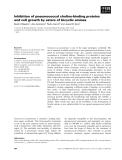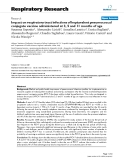
Pneumococcal infections
-
Streptococcus pneumoniaeis one of the major pathogens worldwide. The use of currently available antibiotics to treat pneumococcal diseases is ham-pered by increasing resistance levels; also, capsular polysaccharide-based vaccination is of limited efficacy. Therefore, it is desirable to find targets for the development of new antimicrobial drugs specifically designed to fight pneumococcal infections.
 13p
13p  inspiron33
inspiron33
 23-03-2013
23-03-2013
 44
44
 3
3
 Download
Download
-
Tuyển tập các báo cáo nghiên cứu về y học được đăng trên tạp chí y học 'Respiratory Research cung cấp cho các bạn kiến thức về ngành y đề tài:" Impact on respiratory tract infections of heptavalent pneumococcal conjugate vaccine administered at 3, 5 and 11 months of age...
 9p
9p  toshiba12
toshiba12
 21-10-2011
21-10-2011
 40
40
 4
4
 Download
Download
-
Inpatient Therapy Pneumococcal pneumonia is readily treatable with β-lactam antibiotics. The conventional dosages shown in Table 128-5 are acceptable against intermediately resistant strains and against many or most fully resistant isolates. Recommended agents include ceftriaxone and cefotaxime. Ampicillin is also widely used, usually in the form of ampicillin/sulbactam. The likely efficacy of newer quinolones such as moxifloxacin, macrolides such as azithromycin, and clindamycin is discussed above.
 5p
5p  colgate_colgate
colgate_colgate
 21-12-2010
21-12-2010
 78
78
 3
3
 Download
Download
-
Prevention Capsular Polysaccharide Vaccine The pneumococcal capsular polysaccharide vaccine administered to adults since the early 1980s contains 25 µg per dose of capsular polysaccharide from each of the 23 most prevalent serotypes of S. pneumoniae. Vaccination stimulates antibody to most serotypes in most recipients. One case-control study showed a protection rate of 85% lasting ≥5 years in adults
 10p
10p  colgate_colgate
colgate_colgate
 21-12-2010
21-12-2010
 71
71
 3
3
 Download
Download
-
Acute Sinusitis Just as the pathogenesis and microbial etiology of acute rhinosinusitis are similar to those of otitis media, so are the principles of diagnosis and treatment. The diagnosis is often empirical, and the less rigorously it is made, the more irrelevant antibiotics are likely to be.
 5p
5p  colgate_colgate
colgate_colgate
 21-12-2010
21-12-2010
 69
69
 4
4
 Download
Download
-
Antibiotic Regimens Otitis Media (Table 128-4) Current treatment recommendations for otitis media are based on the following points: (1) Acute otitis media is the most common diagnosis leading to an antibiotic prescription in the United States. (2) The diagnosis is often based on inadequate evidence for true middle-ear infection. (3) In proven cases, S. pneumoniae and H. influenzae are the most likely causes.
 5p
5p  colgate_colgate
colgate_colgate
 21-12-2010
21-12-2010
 63
63
 3
3
 Download
Download
-
Pneumococcal Infections: Treatment Antibiotic Susceptibility β-Lactam antibiotics, the cornerstone of therapy for serious pneumococcal infection, bind covalently to the active site and thereby block the action of enzymes (endo-, trans-, and carboxypeptidases) needed for cell-wall synthesis. Because these enzymes were identified by their reaction with radiolabeled penicillin, they are called penicillin-binding proteins. Until the late 1970s, virtually all clinical isolates of S. pneumoniae were susceptible to penicillin (i.e., were inhibited in vitro by concentrations of ...
 5p
5p  colgate_colgate
colgate_colgate
 21-12-2010
21-12-2010
 63
63
 2
2
 Download
Download
-
Physical Findings Patients with pneumococcal pneumonia usually appear ill and have a grayish, anxious appearance that differs from that of persons with viral or mycoplasmal pneumonia. Temperature, pulse, and respiratory rate are typically elevated. Elderly patients may have only a slight temperature elevation or may be afebrile. Hypothermia may be documented instead of fever and is associated with increased morbidity and mortality. Pleuritic chest pain may cause diminished respiratory excursion (splinting) on the affected side.
 6p
6p  colgate_colgate
colgate_colgate
 21-12-2010
21-12-2010
 61
61
 3
3
 Download
Download
-
Diagnostic Microbiology In patients with community-acquired pneumonia, a pneumococcal etiology is strongly suggested by the microscopic demonstration of large numbers of PMNs and slightly elongated gram-positive cocci in pairs and chains in the sputum. A sample such as the one shown in Fig. 128-2 is highly specific for pneumococcal infection of the lower airways. In the absence of such microscopic findings, the identification of pneumococci by culture is less specific, possibly reflecting colonization of the upper airways.
 5p
5p  colgate_colgate
colgate_colgate
 21-12-2010
21-12-2010
 67
67
 3
3
 Download
Download
-
Specific Infections Caused by S. Pneumoniae S. pneumoniae causes infections of the middle ear, sinuses, trachea, bronchi, and lungs (Table 128-2) by direct spread from the nasopharyngeal site of colonization. Infections of the central nervous system (CNS), heart valves, bones, joints, and peritoneal cavity usually arise by hematogenous spread. Peritoneal infection may also result from ascent via the fallopian tubes. The CNS may also be infected by drainage from nasopharyngeal lymphatics or veins or by contiguous spread of organisms (e.g., through a tear in the dura).
 6p
6p  colgate_colgate
colgate_colgate
 21-12-2010
21-12-2010
 69
69
 3
3
 Download
Download
-
Nonimmunologic Mechanisms Nonimmunologic mechanisms that protect against pneumonia include filtration of air as it passes through the nasopharynx, the glottal reflex, laryngeal closure, the cough reflex, clearance of organisms from the lower airways by ciliated cells, and ingestion by pulmonary macrophages and PMNs of small bacterial inocula that manage to reach alveolar spaces. Respiratory virus infection, chronic pulmonary disease, or heart failure compromises these mechanisms, predisposing to the development of pneumococcal pneumonia.
 5p
5p  colgate_colgate
colgate_colgate
 21-12-2010
21-12-2010
 68
68
 2
2
 Download
Download
-
Harrison's Internal Medicine Chapter 128. Pneumococcal Infections Pneumococcal Infections: Introduction Streptococcus pneumoniae (the pneumococcus) was recognized as a major cause of pneumonia in the 1880s. Although the name Diplococcus pneumoniae was originally assigned to the pneumococcus, the organism was renamed Streptococcus pneumoniae because, like other streptococci, it grows in chains in liquid medium.
 6p
6p  colgate_colgate
colgate_colgate
 21-12-2010
21-12-2010
 61
61
 2
2
 Download
Download
-
Nontypable H. influenzae Nontypable H. influenzae is a common cause of community-acquired bacterial pneumonia in adults. Nontypable H. influenzae pneumonia is especially common among patients with COPD or AIDS. The clinical features of H. influenzae pneumonia are similar to those of other types of bacterial pneumonia (including pneumococcal pneumonia). Patients present with fever, cough, and purulent sputum, usually of several days' duration. Chest radiography reveals alveolar infiltrates in a patchy or lobar distribution.
 6p
6p  colgate_colgate
colgate_colgate
 21-12-2010
21-12-2010
 69
69
 5
5
 Download
Download
-
Other Organisms In the absence of meningitis, endocarditis caused by Streptococcus pneumoniae with a penicillin MIC of ≤1.0 can be treated with IV penicillin (4 million units every 4 h), ceftriaxone (2 g/d as a single dose), or cefotaxime (at a comparable dosage). Infection caused by pneumococcal strains with a penicillin MIC of ≥2.0 should be treated with vancomycin. Until the strain's susceptibility to penicillin is established, therapy should consist of vancomycin plus ceftriaxone, especially if concurrent meningitis is suspected. P.
 5p
5p  thanhongan
thanhongan
 07-12-2010
07-12-2010
 80
80
 4
4
 Download
Download
-
Current recommendations also include influenza vaccine for routine annual administration to individuals with chronic illness at any age, to persons living in the same household as chronically ill individuals, and to all adults 50 years of age. Polyvalent pneumococcal polysaccharide vaccine is similarly recommended for adults ≥65 years of age and for all chronically ill persons.
 5p
5p  thanhongan
thanhongan
 07-12-2010
07-12-2010
 99
99
 6
6
 Download
Download
CHỦ ĐỀ BẠN MUỐN TÌM



























